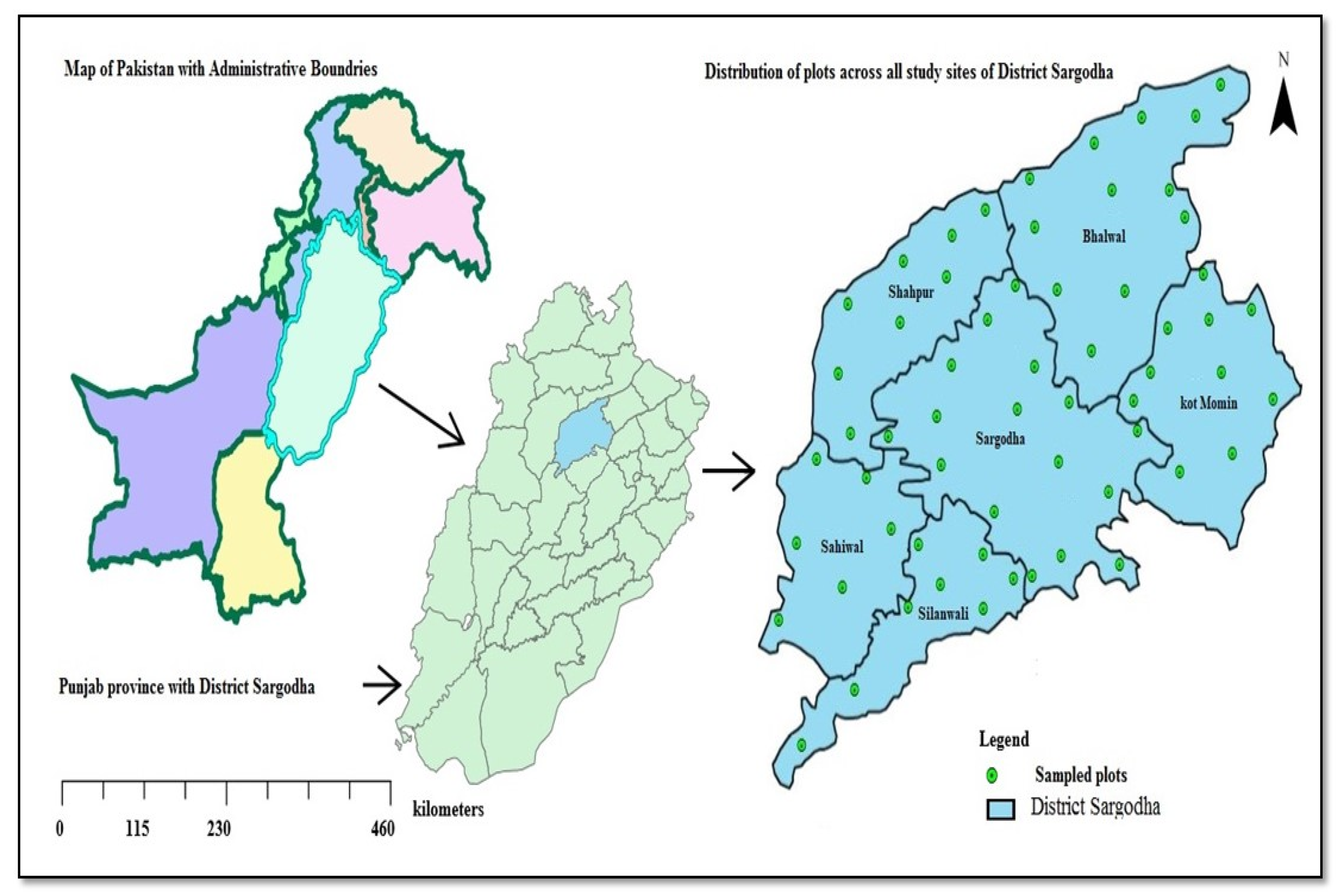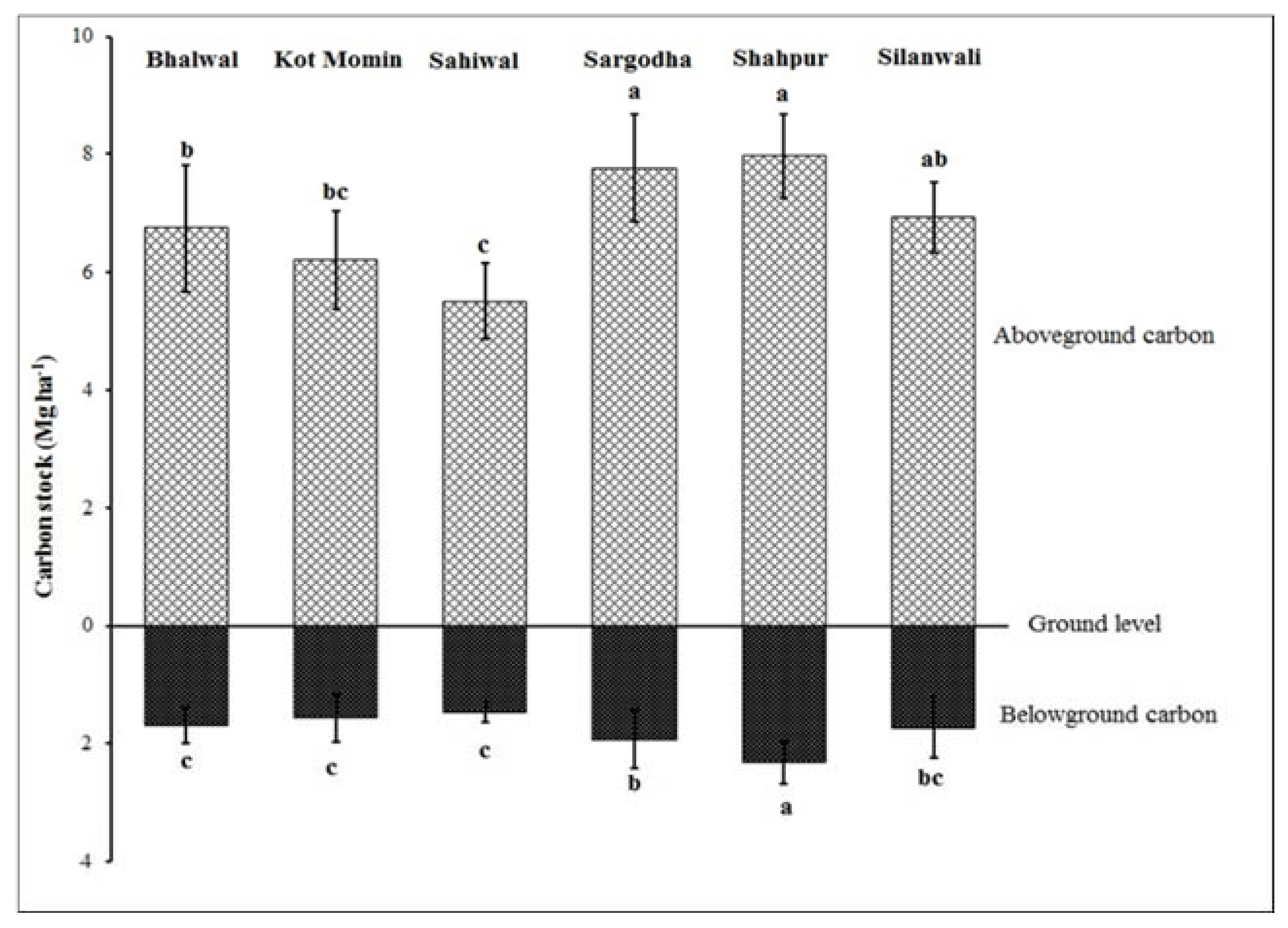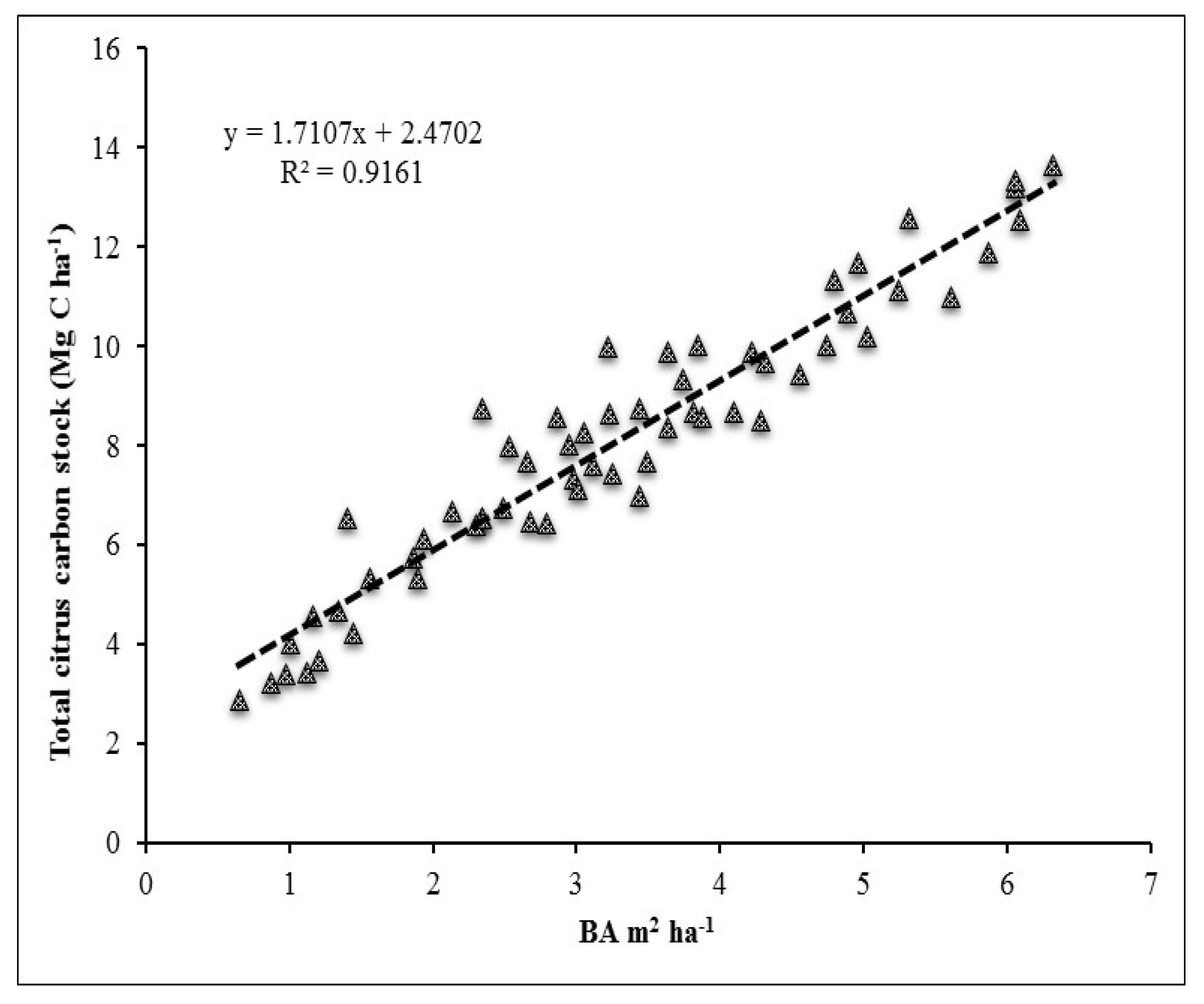Assessing the Contribution of Citrus Orchards in Climate Change Mitigation through Carbon Sequestration in Sargodha District, Pakistan
Abstract
:1. Introduction
2. Materials and Methods
2.1. Description of Study Sites and Sampling Methodology
2.2. Tree Biomass and Carbon Estimation
2.3. Soil Sampling and Analysis
2.4. Statistical Analysis
3. Results and Discussion
3.1. Citrus Biomass and Carbon Stock
3.2. Soil Carbon Density
3.3. Total Carbon Stock (Biomass + Soil) of System
4. Conclusions
Author Contributions
Funding
Institutional Review Board Statement
Informed Consent Statement
Data Availability Statement
Acknowledgments
Conflicts of Interest
References
- Iglesias, D.J.; Quinones, A.; Font, A.; Martínez-Alcántara, B.; Forner-Giner, M.Á.; Legaz, F.; Primo-Millo, E. Carbon balance of citrus plantations in Eastern Spain. Agric. Ecosyst. Environ. 2013, 171, 103–111. [Google Scholar] [CrossRef]
- Kumar, K.K.; Nagai, M.; Witayangkurn, A.; Kritiyutanant, K.; Nakamura, S. Above Ground Biomass Assessment from Combined Optical and SAR Remote Sensing Data in Surat Thani Province, Thailand. J. Geogr. Inf. Syst. 2016, 08, 506–516. [Google Scholar] [CrossRef] [Green Version]
- Stocker, T. Climate Change 2013: The Physical Science Basis: Working Group I Contribution to the Fifth Assessment Report of the Intergovernmental Panel on Climate Change; Cambridge University Press: Cambridge, UK, 2014. [Google Scholar]
- Parry, M.; Parry, M.L.; Canziani, O.; Palutikof, J.; Van der Linden, P.; Hanson, C. Climate Change 2007-Impacts, Adaptation and Vulnerability: Working Group II Contribution to the Fourth Assessment Report of the IPCC; Cambridge University Press: Cambridge, UK, 2007; Volume 4. [Google Scholar]
- Chavan, B.; Rasal, G. Potentiality of Carbon Sequestration in six year ages young plant from University campus of Aurangabad. Glob. J. Res. Eng. 2011, 11, 7-C. [Google Scholar]
- Victor, A.D.; Valery, N.N.; Louis, Z.; Aimé, V.B.T.; Aliou, S. Carbon Sequestration Potential and Economic Value in Agroforestry Parkland to Tectona grandis L. f.(Verbenaceae) in Central Africa: A Case Study to Department of Poli (Northern Region in Cameroon). Adv. Res. 2019, 18, 1–16. [Google Scholar] [CrossRef]
- Chave, J.; Andalo, C.; Brown, S.; Cairns, M.A.; Chambers, J.; Eamus, D.; Fölster, H.; Fromard, F.; Higuchi, N.; Kira, T.; et al. Tree allometry and improved estimation of carbon stocks and balance in tropical forests. Oecologia 2005, 145, 87–99. [Google Scholar] [CrossRef]
- Yadav, R.P.; Gupta, B.; Bhutia, P.L.; Bisht, J.K. Socioeconomics and sources of livelihood security in Central Himalaya, India: A case study. Int. J. Sustain. Dev. World Ecol. 2017, 24, 545–553. [Google Scholar] [CrossRef]
- Yasin, G.; Nawaz, M.; Siddiqui, M.; Niazi, N. Biomass, carbon stocks and CO2 sequestration in three different aged irrigated populus deltoides bartr. Ex marsh. Bund planting agroforestry systems. Appl. Ecol. Environ. Res. 2018, 16, 6239–6252. [Google Scholar] [CrossRef]
- Yadav, R.P.; Gupta, B.; Bhutia, P.L.; Bisht, J.K.; Pattanayak, A.; Meena, V.S.; Choudhary, M.; Tiwari, P. Biomass and carbon budgeting of sustainable agroforestry systems as ecosystem service in Indian Himalayas. Int. J. Sustain. Dev. World Ecol. 2019, 26, 460–470. [Google Scholar] [CrossRef]
- Raj, A.; Jhariya, M.K.; Pithoura, F. Need of agroforestry and impact on ecosystem. J. Plant Dev. Sci. Es 2014, 6, 577–581. [Google Scholar]
- Nawaz, M.; Yousaf, M.; Yasin, G.; Gul, S.; Ahmed, I.; Abdullah, M.; Rafay, M.; Tanvir, M.; Asif, M.; Afzal, S. Agroforestry status and its role to sequester atmospheric CO2 under semi-arid climatic conditions in Pakistan. Appl. Ecol. Environ. Res. 2018, 16, 645–661. [Google Scholar] [CrossRef]
- Mohan Kumar, B.; Ramachandran Nair, P. Carbon Sequestration Potential of Agroforestry Systems; Springer: Berlin, Germany, 2011. [Google Scholar]
- Nair, P.K.R.; Kumar, B.M.; Nair, V.D. Agroforestry as a strategy for carbon sequestration. J. Plant Nutr. Soil Sci. 2009, 172, 10–23. [Google Scholar] [CrossRef]
- Qubaja, R.; Yang, F.; Amer, M.; Tatarinov, F.; Yakir, D. Ecophysiology of an urban citrus orchard. Urban For. Urban Green. 2021, 65, 127361. [Google Scholar] [CrossRef]
- Yixiang, W.A.N.G.; Boqi, W.E.N.G.; Na, T.I.A.N.; Zhong, Z.; Mingkuang, W.A.N.G. Soil organic carbon stocks of citrus orchards in Yongchun county, Fujian Province, China. Pedosphere 2017, 27, 985–990. [Google Scholar]
- Xiaolian, W.; Yueqing, C.; Youjin, L.; Xia, C.; Yonghong, X. Carbon sequestration and storage of citrus orchard system in Three Gorges Reservoir region of Chongqing, Southwest China. J. Agric. Sci. 2014, 27, 693–698. [Google Scholar]
- Liguori, G.; Gugliuzza, G.; Inglese, P. Evaluating carbon fluxes in orange orchards in relation to planting density. J. Agric. Sci. 2009, 147, 637–645. [Google Scholar] [CrossRef]
- Iglesias, D.J.; Lliso, I.; Tadeo, F.R.; Talon, M. Regulation of photosynthesis through source: Sink imbalance in citrus is mediated by carbohydrate content in leaves. Physiol. Plant. 2002, 116, 563–572. [Google Scholar] [CrossRef]
- Marti, B.V.; Estornell, J.; Cortés, I.L.; Martí-Gavilá, J. Calculation of biomass volume of citrus trees from an adapted dendrometry. Biosyst. Eng. 2012, 112, 285–292. [Google Scholar] [CrossRef] [Green Version]
- Yadav, R.; Bisht, J.K.; Pandey, B.M. Above ground biomass and carbon stock of fruit tree based land use systems in Indian Himalaya. Ecoscan 2015, 9, 779–783. [Google Scholar]
- Sharif, M.; Farooq, U.; Malik, W.; Bashir, M. Citrus Marketing in Punjab: Constraints and Potential for Improvement [with Comments]. Pak. Dev. Rev. 2005, 44, 673–694. [Google Scholar] [CrossRef] [Green Version]
- Usman, M.; Ashraf, I.; Chaudhary, K.M.; Talib, U. Factors impeding citrus supply chain in Central Punjab, Pakistan. Int. J. Agric. Ext. 2018, 6, 01–05. [Google Scholar] [CrossRef] [Green Version]
- Segura, M.; Kanninen, M.; Suárez, D. Allometric models for estimating above-ground biomass of shade trees and coffee bushes grown together. Agrofor. Syst. 2006, 68, 143–150. [Google Scholar] [CrossRef]
- Akram, B.; Abbas, F.; Ibrahim, M.; Nawaz, M.; Zahra, S.; Salik, M.; Hammad, H. Above-ground carbon pools of citrus acreage in Pakistan. JAPS J. Anim. Plant Sci. 2017, 27, 1903–1908. [Google Scholar]
- Mobeen, M.; Ahmed, H.; Ullah, F.; Riaz, M.O.; Mustafa, I.; Khan, M.R.; Hanif, M.U.; Muhammad, M. Impact of climate change on the precipitation pattern of district Sargodha, Pakistan. Int. J. Clim. Chang. Strat. Manag. 2017, 9, 21–35. [Google Scholar] [CrossRef]
- Pearson, T.; Walker, S.; Brown, S. Sourcebook for Land Use, Land-Use Change and Forestry Projects. 2013. Available online: http://hdl.handle.net/10986/16491 (accessed on 10 October 2021).
- Schroth, G.; D’Angelo, S.A.; Teixeira, W.G.; Haag, D.; Lieberei, R. Conversion of secondary forest into agroforestry and monoculture plantations in Amazonia: Consequences for biomass, litter and soil carbon stocks after 7 years. For. Ecol. Manag. 2002, 163, 131–150. [Google Scholar] [CrossRef]
- Brown, S. Estimating Biomass and Biomass Change of Tropical Forests: A Primer; Food & Agriculture Org.: Roma, Italy, 1997; Volume 134. [Google Scholar]
- Mehta, L.C.; Singh, J.; Chauhan, P.S.; Singh, B.; Manhas, R.K. Biomass accumulation and carbon storage in six-year old Citrus reticulata Blanco plantation. Indian For. 2016, 142, 563–568. [Google Scholar]
- Nawaz, M.F.; Shah, S.A.A.; Gul, S.; Afzal, S.; Ahmad, I.; Ghaffar, A. Carbon sequestration and production of Eucalyp-tus camaldulensis plantations on marginal sandy agricultural lands. Pak. J. Agric. Sci. 2017, 54, 335–342. [Google Scholar]
- Thomas, S.C.; Martin, A.R. Carbon Content of Tree Tissues: A Synthesis. Forests 2012, 3, 332–352. [Google Scholar] [CrossRef] [Green Version]
- Arora, G.; Chaturvedi, S.; Kaushal, R.; Nain, A.; Tewari, S.; ALAM, N.M.; Chaturvedi, O.P. Growth, biomass, carbon stocks, and sequestration in an age series of Populus deltoides plantations in Tarai region of central Himalaya. Turk. J. Agric. For. 2014, 38, 550–560. [Google Scholar] [CrossRef]
- Walkley, A.; Black, I.A. An examination of the Degtjareff method for determining soil organic matter, and a proposed modification of the chromic acid titration method. Soil Sci. 1934, 37, 29–38. [Google Scholar] [CrossRef]
- Gratani, L.; Varone, L.; Catoni, R. Relationship between net photosynthesis and leaf respiration in Mediterranean ever-green species. Photosynthetica 2008, 46, 567–573. [Google Scholar] [CrossRef]
- Liu, Z.-W.; Chen, R.-S.; Song, Y.-X.; Han, C.-T. Above-ground biomass and water storage allocation in alpine willow shrubs in the Qilian Mountains in China. J. Mt. Sci. 2015, 12, 207–217. [Google Scholar] [CrossRef]
- Dash, M.C.; Behera, N. Carbon sequestration and role of earthworms in Indian land uses: A review. Ecoscan 2013, 7, 1–7. [Google Scholar]
- Rajput, B.S.; Bhardwaj, D.R.; Pala, N.A. Factors influencing biomass and carbon storage potential of different land use systems along an elevational gradient in temperate northwestern Himalaya. Agrofor. Syst. 2017, 91, 479–486. [Google Scholar] [CrossRef] [Green Version]
- Haile, S.G.; Nair, P.K.R.; Nair, V.D. Carbon Storage of Different Soil-Size Fractions in Florida Silvopastoral Systems. J. Environ. Qual. 2008, 37, 1789–1797. [Google Scholar] [CrossRef] [PubMed]
- Jana, B.K.; Biswas, S.; Majumder, M.; Roy, P.K.; Mazumdar, A. Carbon sequestration rate and above-ground biomass carbon potential of four young species. J. Ecol. Nat. Environ. 2009, 1, 15–24. [Google Scholar]
- Okuda, H.; Noda, K.; Sawamoto, T.; Tsuruta, H.; Hirabayashi, T.; Yonemoto, J.Y.; Yagi, K. Emission of N2O and CO2 and Uptake of CH4 in Soil from a Satsuma Mandarin Orchard under Mulching Cultivation in Central Japan. J. Jpn. Soc. Hortic. Sci. 2007, 76, 279–287. [Google Scholar] [CrossRef] [Green Version]
- Kell, D.B. Large-scale sequestration of atmospheric carbon via plant roots in natural and agricultural ecosystems: Why and how. Philos. Trans. R. Soc. B Biol. Sci. 2012, 367, 1589–1597. [Google Scholar] [CrossRef] [PubMed] [Green Version]
- Chiti, T.; Díaz-Pinés, E.; Rubio, A. Soil organic carbon stocks of conifers, broadleaf and evergreen broadleaf forests of Spain. Biol. Fertil. Soils 2012, 48, 817–826. [Google Scholar] [CrossRef]
- Chauhan, S.K.; Sharma, R.; Singh, B.; Sharma, S.C. Biomass production, carbon sequestration and economics of on-farm poplar plantations in Punjab, India. J. Appl. Nat. Sci. 2015, 7, 452–458. [Google Scholar] [CrossRef]
- Verma, A.; Kaushal, R.; Alam, N.M.; Mehta, H.; Chaturvedi, O.P.; Mandal, D.; Tomar, J.M.S.; Rathore, A.C.; Singh, C. Predictive models for biomass and carbon stocks estimation in Grewia optiva on degraded lands in western Himalaya. Agrofor. Syst. 2014, 88, 895–905. [Google Scholar] [CrossRef]
- Krankina, O.N.; Harmon, M.E. The impact of intensive forest management on carbon stores in forest ecosystems. World Resour. Rev. 1994, 6, 161–177. [Google Scholar]
- Bajigo, A.; Tadesse, M.; Moges, Y.; Anjulo, A. Estimation of carbon stored in agroforestry practices in Gununo Water-shed, Wolayitta Zone, Ethiopia. J. Ecosyst. Ecography 2015, 5, 1. [Google Scholar]
- Winjum, J.K.; Dixon, R.K.; Schroeder, P.E. Estimating the global potential of forest and agroforest management practices to sequester carbon. Water Air Soil Pollut. 1992, 64, 213–227. [Google Scholar] [CrossRef]



| Study Sites | # Plots (0.405 ha) | Basal Diameter (cm) | Height (m) |
|---|---|---|---|
| Bhalwal | 60 | 13.21 ± 3.01 | 3.92 ± 0.71 |
| Kot Momin | 50 | 11.75 ± 2.54 | 3.34 ± 1.26 |
| Sahiwal | 30 | 10.67 ± 2.09 | 3.13 ± 0.59 |
| Sargodha | 80 | 13.42 ± 2.70 | 3.59 ± 0.98 |
| Shahpur | 40 | 13.97 ± 2.39 | 4.03 ± 0.71 |
| Silanwali | 40 | 12.64 ± 1.61 | 3.37 ± 0.51 |
| Study Sites | Above-Ground Biomass (Mg ha−1) | Below-Ground Biomass (Mg ha−1) | Total Biomass (Mg ha−1) |
|---|---|---|---|
| Bhalwal | 14.06 b ± 2.62 | 3.52 c ± 0.65 | 17.58 cd ± 3.27 |
| Kot Momin | 12.94 bc ± 3.51 | 3.27 c ± 0.87 | 16.21 cd ± 4.39 |
| Sahiwal | 11.48 c ± 1.35 | 3.07 c ± 0.35 | 14.55 d ± 1.70 |
| Sargodha | 16.14 a ± 2.61 | 4.04 b ± 0.66 | 20.18 ab ± 3.26 |
| Shahpur | 16.61 a ± 1.85 | 4.82 a ± 0.77 | 21.43 a ± 2.42 |
| Silanwali | 14.42 ab ± 1.76 | 3.60b c ± 0.44 | 18.02 bc ± 2.19 |
| Study Sites | Above-Ground Biomass (Mg ha−1) | Below-Ground Biomass (Mg ha−1) | Total Biomass (Mg ha−1) |
|---|---|---|---|
| Bhalwal | 14.06 b ± 2.62 | 3.52 c ± 0.65 | 17.58 cd ± 3.27 |
| Kot Momin | 12.94 bc ± 3.51 | 3.27 c ± 0.87 | 16.21 cd ± 4.39 |
| Sahiwal | 11.48 c ± 1.35 | 3.07 c ± 0.35 | 14.55 d ± 1.70 |
| Sargodha | 16.14 a ± 2.61 | 4.04 b ± 0.66 | 20.18 ab ± 3.26 |
| Shahpur | 16.6 a ± 1.85 | 4.82 a ± 0.77 | 21.43 a ± 2.42 |
| Silanwali | 14.42 ab ± 1.76 | 3.60b c ± 0.44 | 18.02 bc ± 2.19 |
| Study Sites | Organic Carbon (%) | Bulk Density (g cm−3) | Soil Carbon Stock (Mg ha−1) | |||
|---|---|---|---|---|---|---|
| 0–15 cm | 15–30 cm | 0–15 cm | 15–30 cm | 0–15 cm | 15–30 cm | |
| Bhalwal | 0.53 b ± 0.05 | 0.47 ab ± 0.04 | 1.39 cd ± 0.04 | 1.46 b ± 0.05 | 11.28 b ± 1.04 | 10.33 bc ± 1.03 |
| Kot Momin | 0.50 bc ± 0.04 | 0.42 bc ± 0.05 | 1.34 d ± 0.03 | 1.39 c ± 0.06 | 10.13 c ± 1.03 | 8.93 d ± 1.54 |
| Sahiwal | 0.46 cd ± 0.06 | 0.39 c ± 0.05 | 1.35 d ± 0.03 | 1.43 bc ± 0.05 | 9.42 c ± 1.11 | 8.60 d ± 1.19 |
| Sargodha | 0.58 a ± 0.05 | 0.49 a ± 0.07 | 1.42 bc ± 0.07 | 1.51 a ± 0.06 | 12.43 a ± 1.19 | 11.21 ab ± 1.74 |
| Shahpur | 0.54 ab ± 0.02 | 0.52 a ± 0.04 | 1.47 ab ± 0.07 | 1.54 a ± 0.09 | 12.14 ab ± 0.94 | 12.06 a ± 1.26 |
| Silanwali | 0.44 d ± 0.07 | 0.40 c ± 0.06 | 1.49 a ± 0.06 | 1.55 a ± 0.05 | 9.81 c ± 1.48 | 9.49 cd ± 1.35 |
| Sampling Sites | Total Biomass Carbon (Mg C ha−1) | Total Soil Carbon (Mg C ha−1) | Total Carbon Stock (Mg C ha−1) |
|---|---|---|---|
| Bhalwal | 8.43 cd ± 1.57 | 21.61 b ± 1.64 | 30.05 b ± 1.62 |
| Kot Momin | 7.78 cd ± 2.10 | 19.06 c ± 1.62 | 26.84 cd ± 2.52 |
| Sahiwal | 6.98 d ± 0.76 | 18.02 c ± 1.78 | 25.07 d ± 1.37 |
| Sargodha | 9.68 ab ± 1.56 | 23.65 a ± 2.23 | 33.34 a ± 2.80 |
| Shahpur | 10.28 a ± 1.16 | 24.21 a ± 1.24 | 34.50 a ± 2.08 |
| Silanwali | 8.65 bc ± 1.05 | 19.31 c ± 1.97 | 27.96 c ± 2.02 |
Publisher’s Note: MDPI stays neutral with regard to jurisdictional claims in published maps and institutional affiliations. |
© 2021 by the authors. Licensee MDPI, Basel, Switzerland. This article is an open access article distributed under the terms and conditions of the Creative Commons Attribution (CC BY) license (https://creativecommons.org/licenses/by/4.0/).
Share and Cite
Yasin, G.; Farrakh Nawaz, M.; Zubair, M.; Qadir, I.; Saleem, A.R.; Ijaz, M.; Gul, S.; Amjad Bashir, M.; Rehim, A.; Rahman, S.U.; et al. Assessing the Contribution of Citrus Orchards in Climate Change Mitigation through Carbon Sequestration in Sargodha District, Pakistan. Sustainability 2021, 13, 12412. https://doi.org/10.3390/su132212412
Yasin G, Farrakh Nawaz M, Zubair M, Qadir I, Saleem AR, Ijaz M, Gul S, Amjad Bashir M, Rehim A, Rahman SU, et al. Assessing the Contribution of Citrus Orchards in Climate Change Mitigation through Carbon Sequestration in Sargodha District, Pakistan. Sustainability. 2021; 13(22):12412. https://doi.org/10.3390/su132212412
Chicago/Turabian StyleYasin, Ghulam, Muhammad Farrakh Nawaz, Muhammad Zubair, Ihsan Qadir, Aansa Rukya Saleem, Muhammad Ijaz, Sadaf Gul, Muhammad Amjad Bashir, Abdur Rehim, Shafeeq Ur Rahman, and et al. 2021. "Assessing the Contribution of Citrus Orchards in Climate Change Mitigation through Carbon Sequestration in Sargodha District, Pakistan" Sustainability 13, no. 22: 12412. https://doi.org/10.3390/su132212412
APA StyleYasin, G., Farrakh Nawaz, M., Zubair, M., Qadir, I., Saleem, A. R., Ijaz, M., Gul, S., Amjad Bashir, M., Rehim, A., Rahman, S. U., & Du, Z. (2021). Assessing the Contribution of Citrus Orchards in Climate Change Mitigation through Carbon Sequestration in Sargodha District, Pakistan. Sustainability, 13(22), 12412. https://doi.org/10.3390/su132212412








